HNN114 HEALTH ASSESSMENT.
VerifiedAdded on 2022/10/15
|10
|2069
|2
AI Summary
Contribute Materials
Your contribution can guide someone’s learning journey. Share your
documents today.

Running head: HNN114 HEALTH ASSESSMENT
1
HNN114 health assessment
Student’s Name
Institutional Affiliation
1
HNN114 health assessment
Student’s Name
Institutional Affiliation
Secure Best Marks with AI Grader
Need help grading? Try our AI Grader for instant feedback on your assignments.
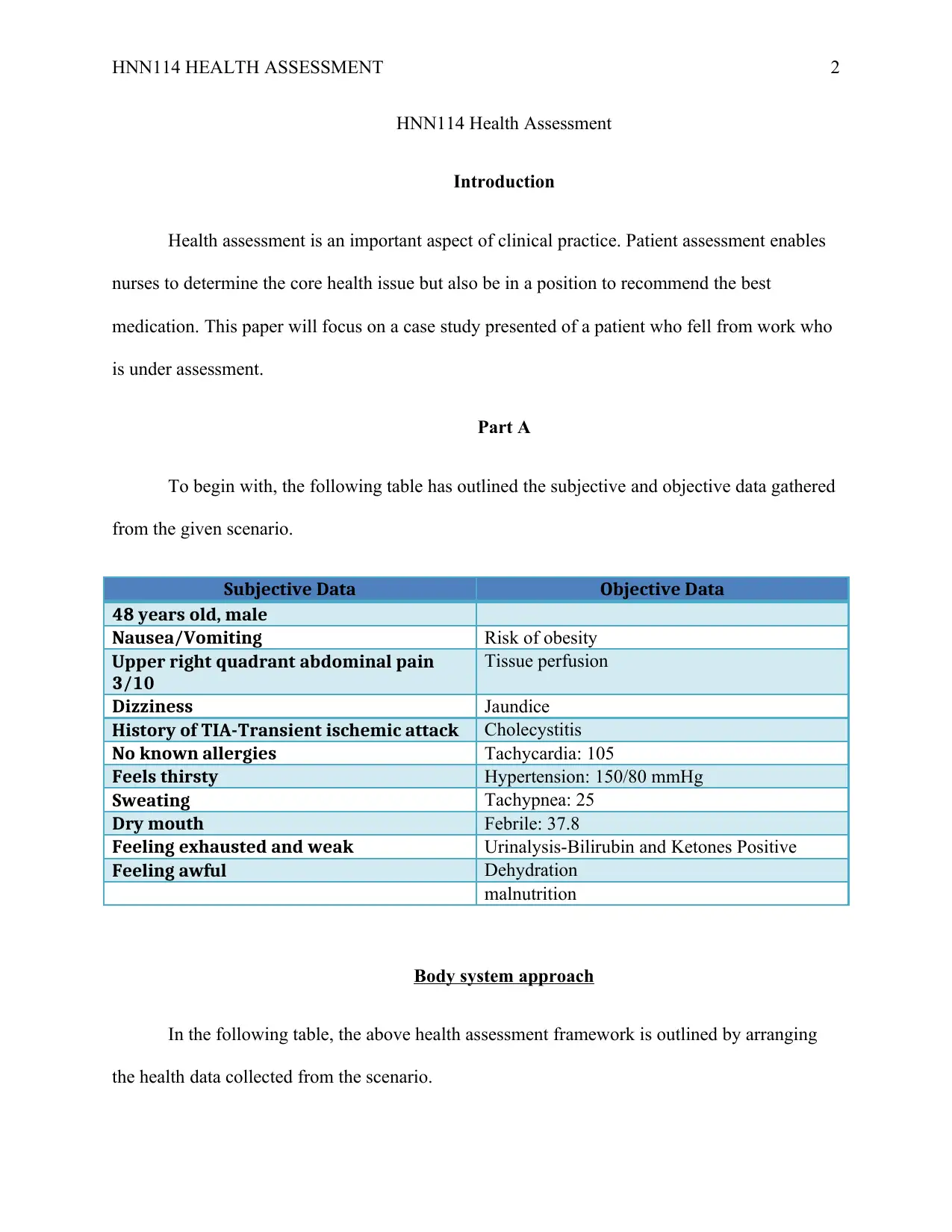
HNN114 HEALTH ASSESSMENT 2
HNN114 Health Assessment
Introduction
Health assessment is an important aspect of clinical practice. Patient assessment enables
nurses to determine the core health issue but also be in a position to recommend the best
medication. This paper will focus on a case study presented of a patient who fell from work who
is under assessment.
Part A
To begin with, the following table has outlined the subjective and objective data gathered
from the given scenario.
Subjective Data Objective Data
48 years old, male
Nausea/Vomiting Risk of obesity
Upper right quadrant abdominal pain
3/10
Tissue perfusion
Dizziness Jaundice
History of TIA-Transient ischemic attack Cholecystitis
No known allergies Tachycardia: 105
Feels thirsty Hypertension: 150/80 mmHg
Sweating Tachypnea: 25
Dry mouth Febrile: 37.8
Feeling exhausted and weak Urinalysis-Bilirubin and Ketones Positive
Feeling awful Dehydration
malnutrition
Body system approach
In the following table, the above health assessment framework is outlined by arranging
the health data collected from the scenario.
HNN114 Health Assessment
Introduction
Health assessment is an important aspect of clinical practice. Patient assessment enables
nurses to determine the core health issue but also be in a position to recommend the best
medication. This paper will focus on a case study presented of a patient who fell from work who
is under assessment.
Part A
To begin with, the following table has outlined the subjective and objective data gathered
from the given scenario.
Subjective Data Objective Data
48 years old, male
Nausea/Vomiting Risk of obesity
Upper right quadrant abdominal pain
3/10
Tissue perfusion
Dizziness Jaundice
History of TIA-Transient ischemic attack Cholecystitis
No known allergies Tachycardia: 105
Feels thirsty Hypertension: 150/80 mmHg
Sweating Tachypnea: 25
Dry mouth Febrile: 37.8
Feeling exhausted and weak Urinalysis-Bilirubin and Ketones Positive
Feeling awful Dehydration
malnutrition
Body system approach
In the following table, the above health assessment framework is outlined by arranging
the health data collected from the scenario.
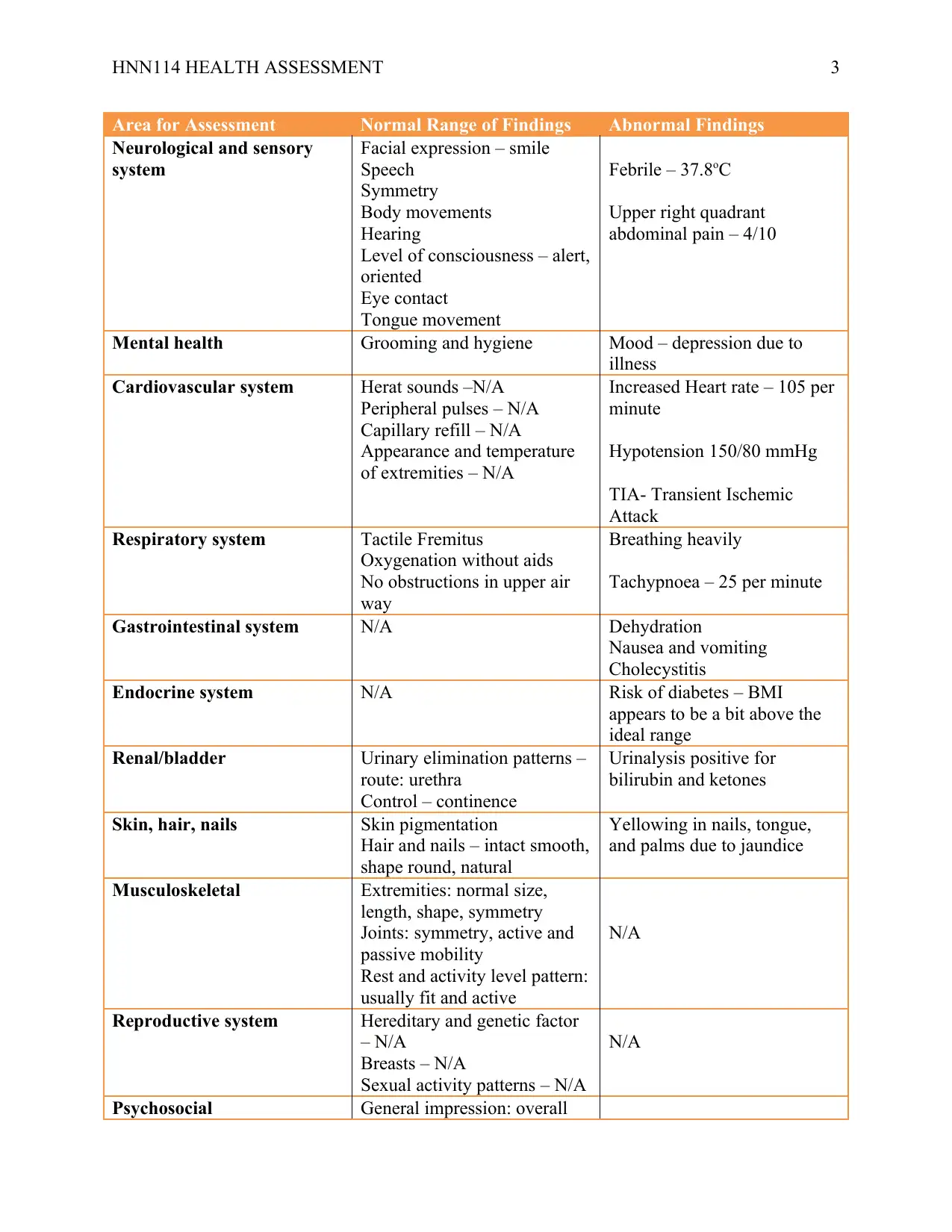
HNN114 HEALTH ASSESSMENT 3
Area for Assessment Normal Range of Findings Abnormal Findings
Neurological and sensory
system
Facial expression – smile
Speech
Symmetry
Body movements
Hearing
Level of consciousness – alert,
oriented
Eye contact
Tongue movement
Febrile – 37.8oC
Upper right quadrant
abdominal pain – 4/10
Mental health Grooming and hygiene Mood – depression due to
illness
Cardiovascular system Herat sounds –N/A
Peripheral pulses – N/A
Capillary refill – N/A
Appearance and temperature
of extremities – N/A
Increased Heart rate – 105 per
minute
Hypotension 150/80 mmHg
TIA- Transient Ischemic
Attack
Respiratory system Tactile Fremitus
Oxygenation without aids
No obstructions in upper air
way
Breathing heavily
Tachypnoea – 25 per minute
Gastrointestinal system N/A Dehydration
Nausea and vomiting
Cholecystitis
Endocrine system N/A Risk of diabetes – BMI
appears to be a bit above the
ideal range
Renal/bladder Urinary elimination patterns –
route: urethra
Control – continence
Urinalysis positive for
bilirubin and ketones
Skin, hair, nails Skin pigmentation
Hair and nails – intact smooth,
shape round, natural
Yellowing in nails, tongue,
and palms due to jaundice
Musculoskeletal Extremities: normal size,
length, shape, symmetry
Joints: symmetry, active and
passive mobility
Rest and activity level pattern:
usually fit and active
N/A
Reproductive system Hereditary and genetic factor
– N/A
Breasts – N/A
Sexual activity patterns – N/A
N/A
Psychosocial General impression: overall
Area for Assessment Normal Range of Findings Abnormal Findings
Neurological and sensory
system
Facial expression – smile
Speech
Symmetry
Body movements
Hearing
Level of consciousness – alert,
oriented
Eye contact
Tongue movement
Febrile – 37.8oC
Upper right quadrant
abdominal pain – 4/10
Mental health Grooming and hygiene Mood – depression due to
illness
Cardiovascular system Herat sounds –N/A
Peripheral pulses – N/A
Capillary refill – N/A
Appearance and temperature
of extremities – N/A
Increased Heart rate – 105 per
minute
Hypotension 150/80 mmHg
TIA- Transient Ischemic
Attack
Respiratory system Tactile Fremitus
Oxygenation without aids
No obstructions in upper air
way
Breathing heavily
Tachypnoea – 25 per minute
Gastrointestinal system N/A Dehydration
Nausea and vomiting
Cholecystitis
Endocrine system N/A Risk of diabetes – BMI
appears to be a bit above the
ideal range
Renal/bladder Urinary elimination patterns –
route: urethra
Control – continence
Urinalysis positive for
bilirubin and ketones
Skin, hair, nails Skin pigmentation
Hair and nails – intact smooth,
shape round, natural
Yellowing in nails, tongue,
and palms due to jaundice
Musculoskeletal Extremities: normal size,
length, shape, symmetry
Joints: symmetry, active and
passive mobility
Rest and activity level pattern:
usually fit and active
N/A
Reproductive system Hereditary and genetic factor
– N/A
Breasts – N/A
Sexual activity patterns – N/A
N/A
Psychosocial General impression: overall
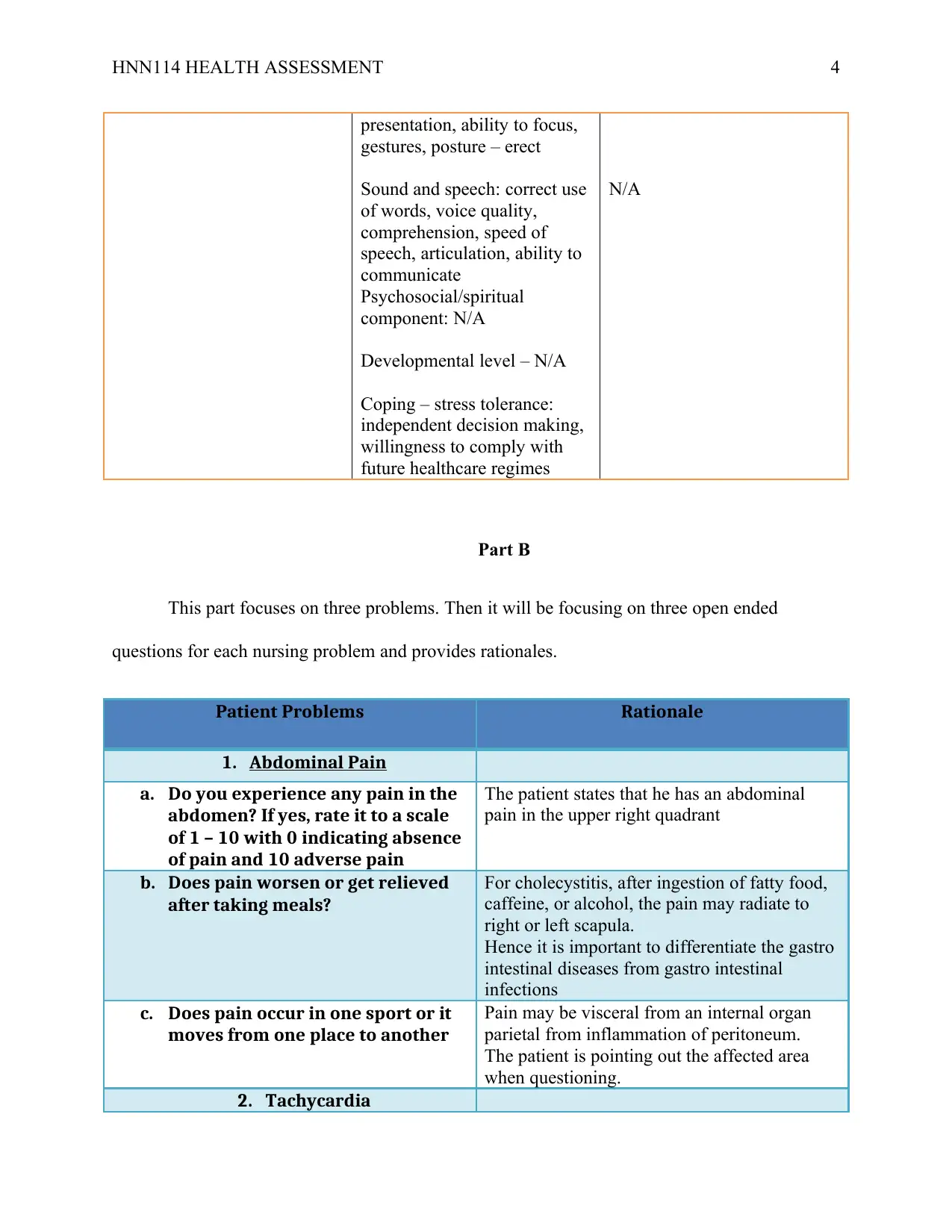
HNN114 HEALTH ASSESSMENT 4
presentation, ability to focus,
gestures, posture – erect
Sound and speech: correct use
of words, voice quality,
comprehension, speed of
speech, articulation, ability to
communicate
Psychosocial/spiritual
component: N/A
Developmental level – N/A
Coping – stress tolerance:
independent decision making,
willingness to comply with
future healthcare regimes
N/A
Part B
This part focuses on three problems. Then it will be focusing on three open ended
questions for each nursing problem and provides rationales.
Patient Problems Rationale
1. Abdominal Pain
a. Do you experience any pain in the
abdomen? If yes, rate it to a scale
of 1 – 10 with 0 indicating absence
of pain and 10 adverse pain
The patient states that he has an abdominal
pain in the upper right quadrant
b. Does pain worsen or get relieved
after taking meals?
For cholecystitis, after ingestion of fatty food,
caffeine, or alcohol, the pain may radiate to
right or left scapula.
Hence it is important to differentiate the gastro
intestinal diseases from gastro intestinal
infections
c. Does pain occur in one sport or it
moves from one place to another
Pain may be visceral from an internal organ
parietal from inflammation of peritoneum.
The patient is pointing out the affected area
when questioning.
2. Tachycardia
presentation, ability to focus,
gestures, posture – erect
Sound and speech: correct use
of words, voice quality,
comprehension, speed of
speech, articulation, ability to
communicate
Psychosocial/spiritual
component: N/A
Developmental level – N/A
Coping – stress tolerance:
independent decision making,
willingness to comply with
future healthcare regimes
N/A
Part B
This part focuses on three problems. Then it will be focusing on three open ended
questions for each nursing problem and provides rationales.
Patient Problems Rationale
1. Abdominal Pain
a. Do you experience any pain in the
abdomen? If yes, rate it to a scale
of 1 – 10 with 0 indicating absence
of pain and 10 adverse pain
The patient states that he has an abdominal
pain in the upper right quadrant
b. Does pain worsen or get relieved
after taking meals?
For cholecystitis, after ingestion of fatty food,
caffeine, or alcohol, the pain may radiate to
right or left scapula.
Hence it is important to differentiate the gastro
intestinal diseases from gastro intestinal
infections
c. Does pain occur in one sport or it
moves from one place to another
Pain may be visceral from an internal organ
parietal from inflammation of peritoneum.
The patient is pointing out the affected area
when questioning.
2. Tachycardia
Secure Best Marks with AI Grader
Need help grading? Try our AI Grader for instant feedback on your assignments.
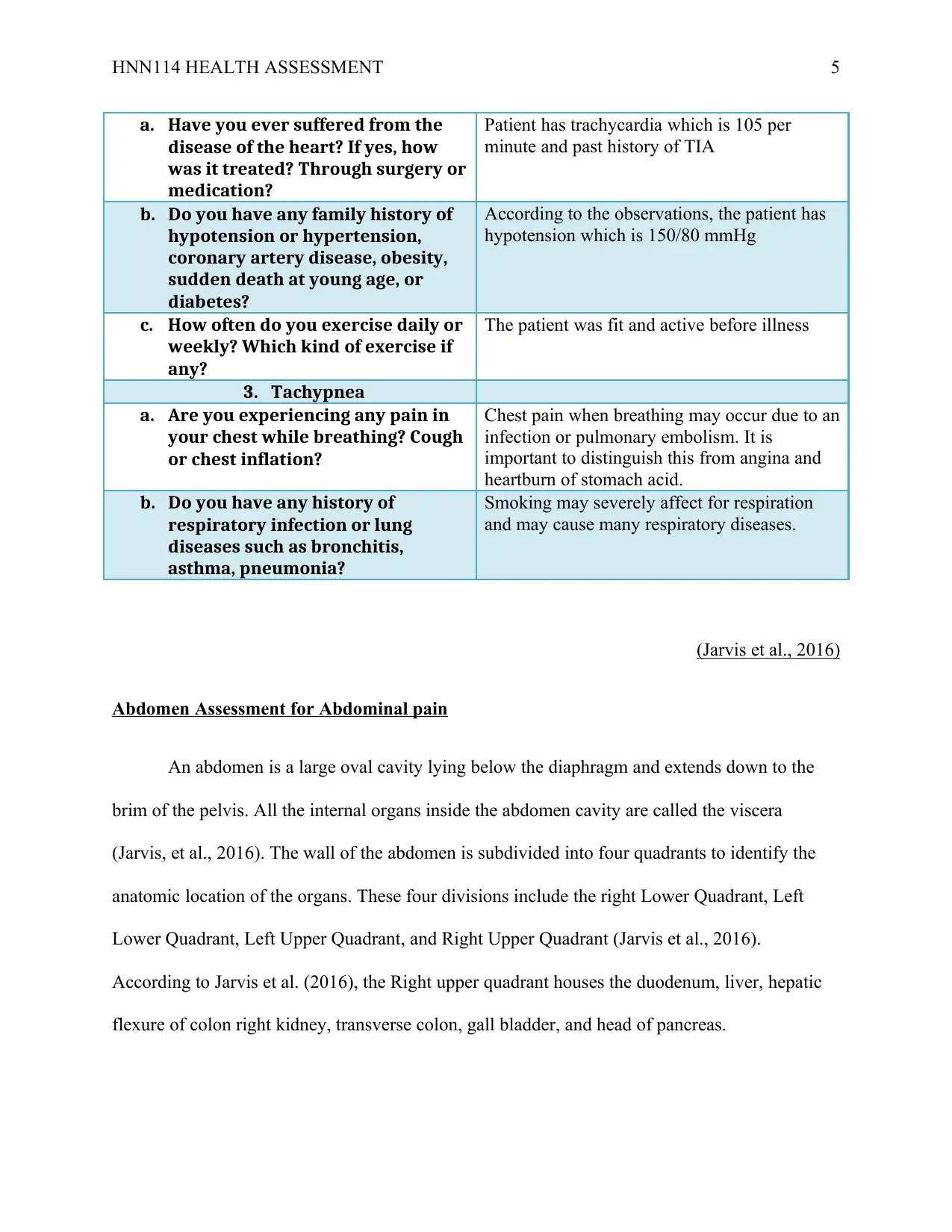
HNN114 HEALTH ASSESSMENT 5
a. Have you ever suffered from the
disease of the heart? If yes, how
was it treated? Through surgery or
medication?
Patient has trachycardia which is 105 per
minute and past history of TIA
b. Do you have any family history of
hypotension or hypertension,
coronary artery disease, obesity,
sudden death at young age, or
diabetes?
According to the observations, the patient has
hypotension which is 150/80 mmHg
c. How often do you exercise daily or
weekly? Which kind of exercise if
any?
The patient was fit and active before illness
3. Tachypnea
a. Are you experiencing any pain in
your chest while breathing? Cough
or chest inflation?
Chest pain when breathing may occur due to an
infection or pulmonary embolism. It is
important to distinguish this from angina and
heartburn of stomach acid.
b. Do you have any history of
respiratory infection or lung
diseases such as bronchitis,
asthma, pneumonia?
Smoking may severely affect for respiration
and may cause many respiratory diseases.
(Jarvis et al., 2016)
Abdomen Assessment for Abdominal pain
An abdomen is a large oval cavity lying below the diaphragm and extends down to the
brim of the pelvis. All the internal organs inside the abdomen cavity are called the viscera
(Jarvis, et al., 2016). The wall of the abdomen is subdivided into four quadrants to identify the
anatomic location of the organs. These four divisions include the right Lower Quadrant, Left
Lower Quadrant, Left Upper Quadrant, and Right Upper Quadrant (Jarvis et al., 2016).
According to Jarvis et al. (2016), the Right upper quadrant houses the duodenum, liver, hepatic
flexure of colon right kidney, transverse colon, gall bladder, and head of pancreas.
a. Have you ever suffered from the
disease of the heart? If yes, how
was it treated? Through surgery or
medication?
Patient has trachycardia which is 105 per
minute and past history of TIA
b. Do you have any family history of
hypotension or hypertension,
coronary artery disease, obesity,
sudden death at young age, or
diabetes?
According to the observations, the patient has
hypotension which is 150/80 mmHg
c. How often do you exercise daily or
weekly? Which kind of exercise if
any?
The patient was fit and active before illness
3. Tachypnea
a. Are you experiencing any pain in
your chest while breathing? Cough
or chest inflation?
Chest pain when breathing may occur due to an
infection or pulmonary embolism. It is
important to distinguish this from angina and
heartburn of stomach acid.
b. Do you have any history of
respiratory infection or lung
diseases such as bronchitis,
asthma, pneumonia?
Smoking may severely affect for respiration
and may cause many respiratory diseases.
(Jarvis et al., 2016)
Abdomen Assessment for Abdominal pain
An abdomen is a large oval cavity lying below the diaphragm and extends down to the
brim of the pelvis. All the internal organs inside the abdomen cavity are called the viscera
(Jarvis, et al., 2016). The wall of the abdomen is subdivided into four quadrants to identify the
anatomic location of the organs. These four divisions include the right Lower Quadrant, Left
Lower Quadrant, Left Upper Quadrant, and Right Upper Quadrant (Jarvis et al., 2016).
According to Jarvis et al. (2016), the Right upper quadrant houses the duodenum, liver, hepatic
flexure of colon right kidney, transverse colon, gall bladder, and head of pancreas.
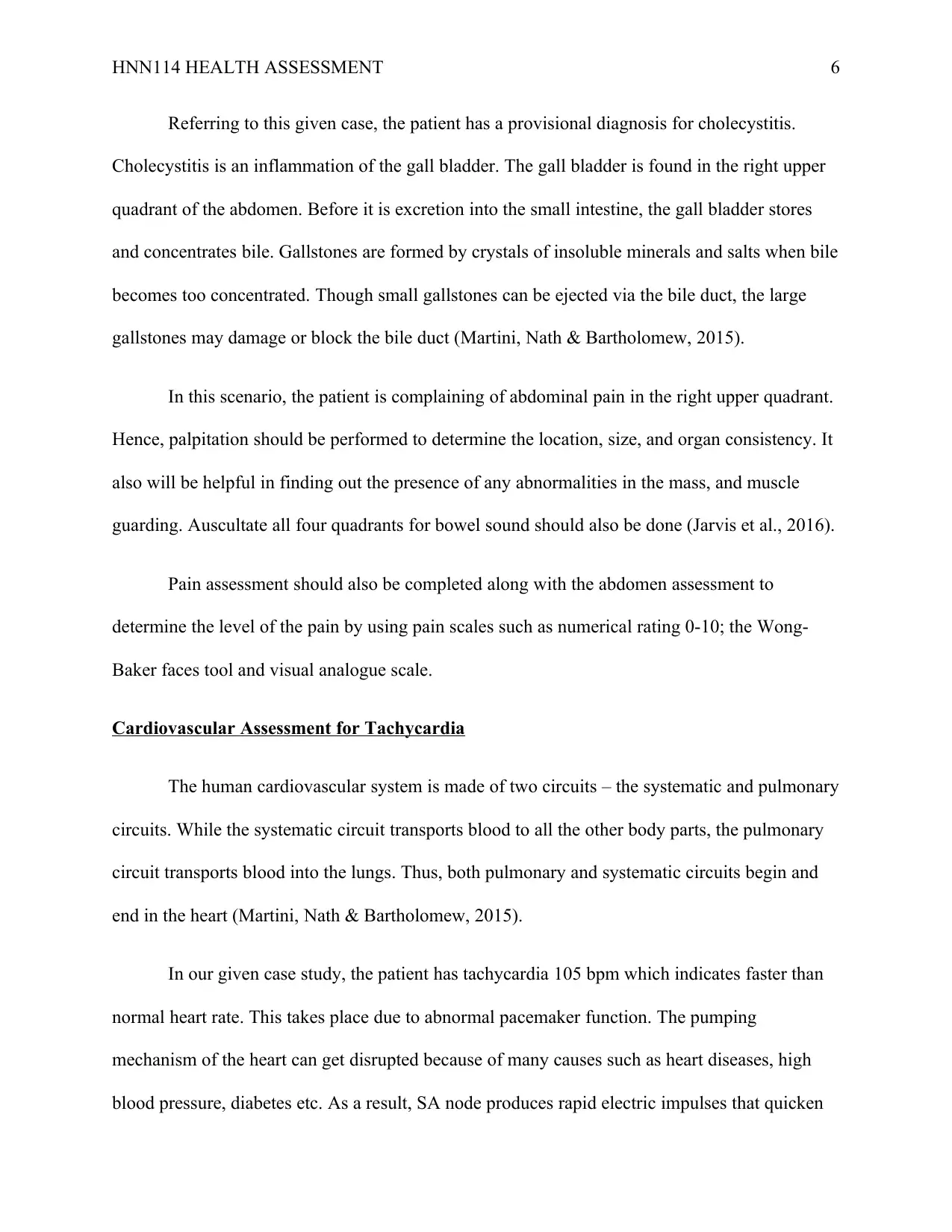
HNN114 HEALTH ASSESSMENT 6
Referring to this given case, the patient has a provisional diagnosis for cholecystitis.
Cholecystitis is an inflammation of the gall bladder. The gall bladder is found in the right upper
quadrant of the abdomen. Before it is excretion into the small intestine, the gall bladder stores
and concentrates bile. Gallstones are formed by crystals of insoluble minerals and salts when bile
becomes too concentrated. Though small gallstones can be ejected via the bile duct, the large
gallstones may damage or block the bile duct (Martini, Nath & Bartholomew, 2015).
In this scenario, the patient is complaining of abdominal pain in the right upper quadrant.
Hence, palpitation should be performed to determine the location, size, and organ consistency. It
also will be helpful in finding out the presence of any abnormalities in the mass, and muscle
guarding. Auscultate all four quadrants for bowel sound should also be done (Jarvis et al., 2016).
Pain assessment should also be completed along with the abdomen assessment to
determine the level of the pain by using pain scales such as numerical rating 0-10; the Wong-
Baker faces tool and visual analogue scale.
Cardiovascular Assessment for Tachycardia
The human cardiovascular system is made of two circuits – the systematic and pulmonary
circuits. While the systematic circuit transports blood to all the other body parts, the pulmonary
circuit transports blood into the lungs. Thus, both pulmonary and systematic circuits begin and
end in the heart (Martini, Nath & Bartholomew, 2015).
In our given case study, the patient has tachycardia 105 bpm which indicates faster than
normal heart rate. This takes place due to abnormal pacemaker function. The pumping
mechanism of the heart can get disrupted because of many causes such as heart diseases, high
blood pressure, diabetes etc. As a result, SA node produces rapid electric impulses that quicken
Referring to this given case, the patient has a provisional diagnosis for cholecystitis.
Cholecystitis is an inflammation of the gall bladder. The gall bladder is found in the right upper
quadrant of the abdomen. Before it is excretion into the small intestine, the gall bladder stores
and concentrates bile. Gallstones are formed by crystals of insoluble minerals and salts when bile
becomes too concentrated. Though small gallstones can be ejected via the bile duct, the large
gallstones may damage or block the bile duct (Martini, Nath & Bartholomew, 2015).
In this scenario, the patient is complaining of abdominal pain in the right upper quadrant.
Hence, palpitation should be performed to determine the location, size, and organ consistency. It
also will be helpful in finding out the presence of any abnormalities in the mass, and muscle
guarding. Auscultate all four quadrants for bowel sound should also be done (Jarvis et al., 2016).
Pain assessment should also be completed along with the abdomen assessment to
determine the level of the pain by using pain scales such as numerical rating 0-10; the Wong-
Baker faces tool and visual analogue scale.
Cardiovascular Assessment for Tachycardia
The human cardiovascular system is made of two circuits – the systematic and pulmonary
circuits. While the systematic circuit transports blood to all the other body parts, the pulmonary
circuit transports blood into the lungs. Thus, both pulmonary and systematic circuits begin and
end in the heart (Martini, Nath & Bartholomew, 2015).
In our given case study, the patient has tachycardia 105 bpm which indicates faster than
normal heart rate. This takes place due to abnormal pacemaker function. The pumping
mechanism of the heart can get disrupted because of many causes such as heart diseases, high
blood pressure, diabetes etc. As a result, SA node produces rapid electric impulses that quicken
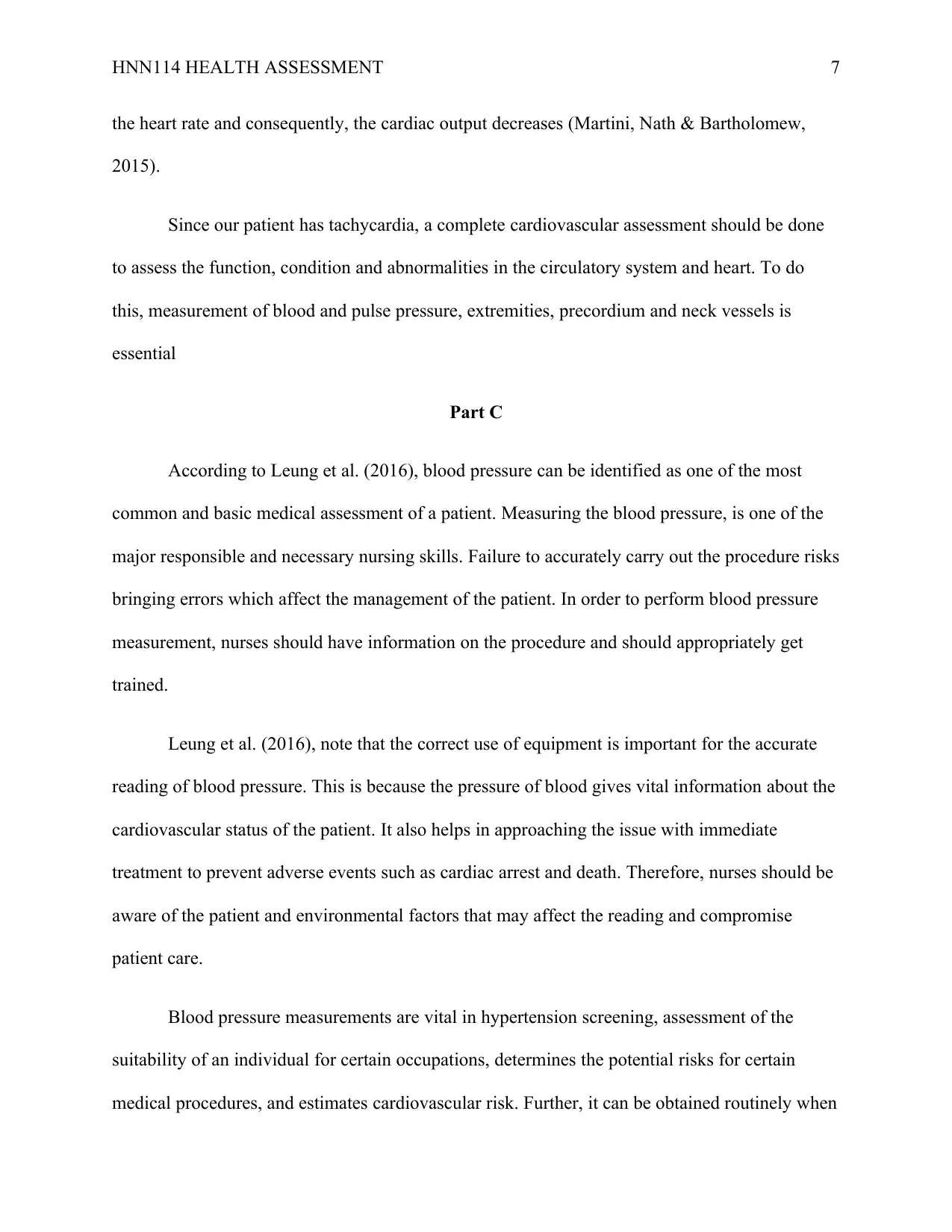
HNN114 HEALTH ASSESSMENT 7
the heart rate and consequently, the cardiac output decreases (Martini, Nath & Bartholomew,
2015).
Since our patient has tachycardia, a complete cardiovascular assessment should be done
to assess the function, condition and abnormalities in the circulatory system and heart. To do
this, measurement of blood and pulse pressure, extremities, precordium and neck vessels is
essential
Part C
According to Leung et al. (2016), blood pressure can be identified as one of the most
common and basic medical assessment of a patient. Measuring the blood pressure, is one of the
major responsible and necessary nursing skills. Failure to accurately carry out the procedure risks
bringing errors which affect the management of the patient. In order to perform blood pressure
measurement, nurses should have information on the procedure and should appropriately get
trained.
Leung et al. (2016), note that the correct use of equipment is important for the accurate
reading of blood pressure. This is because the pressure of blood gives vital information about the
cardiovascular status of the patient. It also helps in approaching the issue with immediate
treatment to prevent adverse events such as cardiac arrest and death. Therefore, nurses should be
aware of the patient and environmental factors that may affect the reading and compromise
patient care.
Blood pressure measurements are vital in hypertension screening, assessment of the
suitability of an individual for certain occupations, determines the potential risks for certain
medical procedures, and estimates cardiovascular risk. Further, it can be obtained routinely when
the heart rate and consequently, the cardiac output decreases (Martini, Nath & Bartholomew,
2015).
Since our patient has tachycardia, a complete cardiovascular assessment should be done
to assess the function, condition and abnormalities in the circulatory system and heart. To do
this, measurement of blood and pulse pressure, extremities, precordium and neck vessels is
essential
Part C
According to Leung et al. (2016), blood pressure can be identified as one of the most
common and basic medical assessment of a patient. Measuring the blood pressure, is one of the
major responsible and necessary nursing skills. Failure to accurately carry out the procedure risks
bringing errors which affect the management of the patient. In order to perform blood pressure
measurement, nurses should have information on the procedure and should appropriately get
trained.
Leung et al. (2016), note that the correct use of equipment is important for the accurate
reading of blood pressure. This is because the pressure of blood gives vital information about the
cardiovascular status of the patient. It also helps in approaching the issue with immediate
treatment to prevent adverse events such as cardiac arrest and death. Therefore, nurses should be
aware of the patient and environmental factors that may affect the reading and compromise
patient care.
Blood pressure measurements are vital in hypertension screening, assessment of the
suitability of an individual for certain occupations, determines the potential risks for certain
medical procedures, and estimates cardiovascular risk. Further, it can be obtained routinely when
Paraphrase This Document
Need a fresh take? Get an instant paraphrase of this document with our AI Paraphraser
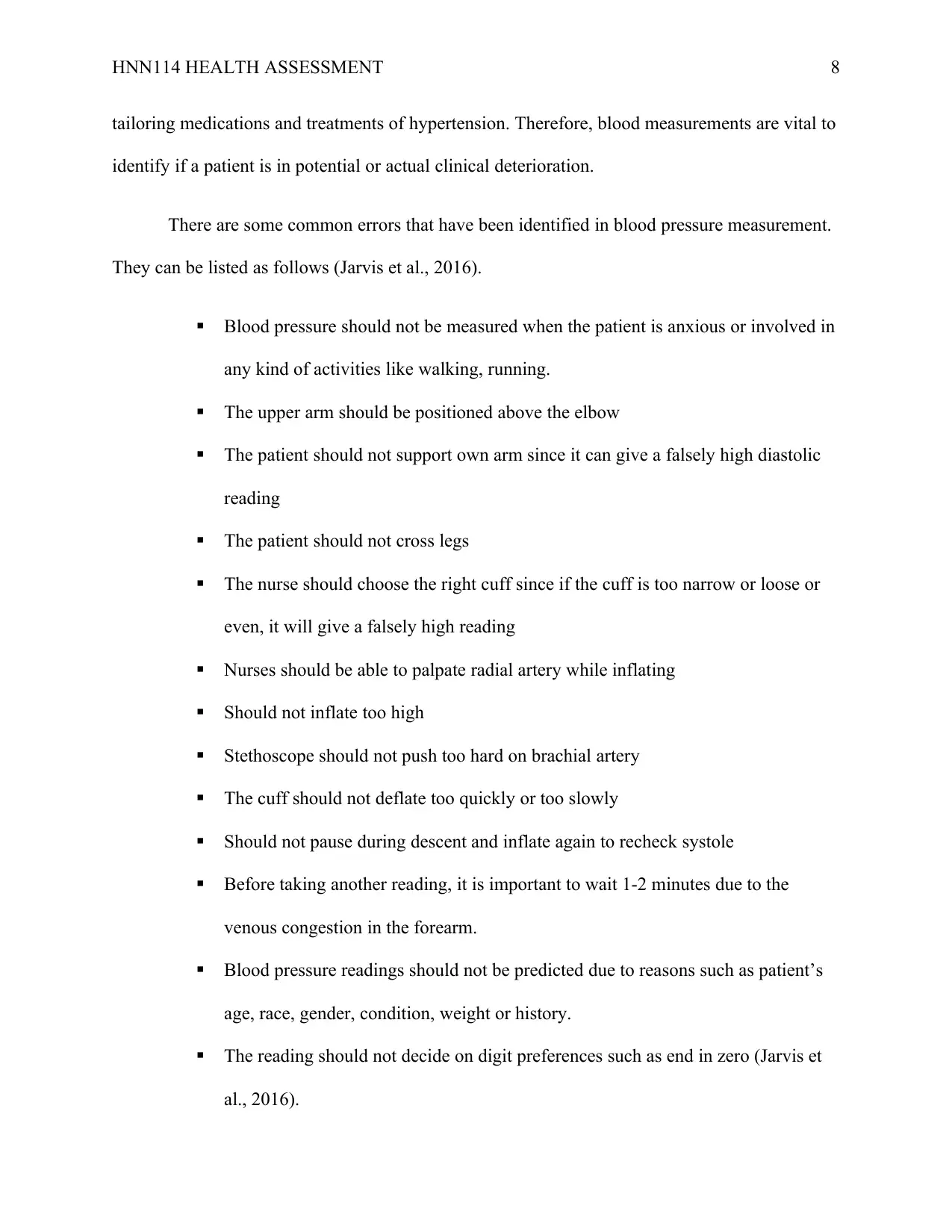
HNN114 HEALTH ASSESSMENT 8
tailoring medications and treatments of hypertension. Therefore, blood measurements are vital to
identify if a patient is in potential or actual clinical deterioration.
There are some common errors that have been identified in blood pressure measurement.
They can be listed as follows (Jarvis et al., 2016).
Blood pressure should not be measured when the patient is anxious or involved in
any kind of activities like walking, running.
The upper arm should be positioned above the elbow
The patient should not support own arm since it can give a falsely high diastolic
reading
The patient should not cross legs
The nurse should choose the right cuff since if the cuff is too narrow or loose or
even, it will give a falsely high reading
Nurses should be able to palpate radial artery while inflating
Should not inflate too high
Stethoscope should not push too hard on brachial artery
The cuff should not deflate too quickly or too slowly
Should not pause during descent and inflate again to recheck systole
Before taking another reading, it is important to wait 1-2 minutes due to the
venous congestion in the forearm.
Blood pressure readings should not be predicted due to reasons such as patient’s
age, race, gender, condition, weight or history.
The reading should not decide on digit preferences such as end in zero (Jarvis et
al., 2016).
tailoring medications and treatments of hypertension. Therefore, blood measurements are vital to
identify if a patient is in potential or actual clinical deterioration.
There are some common errors that have been identified in blood pressure measurement.
They can be listed as follows (Jarvis et al., 2016).
Blood pressure should not be measured when the patient is anxious or involved in
any kind of activities like walking, running.
The upper arm should be positioned above the elbow
The patient should not support own arm since it can give a falsely high diastolic
reading
The patient should not cross legs
The nurse should choose the right cuff since if the cuff is too narrow or loose or
even, it will give a falsely high reading
Nurses should be able to palpate radial artery while inflating
Should not inflate too high
Stethoscope should not push too hard on brachial artery
The cuff should not deflate too quickly or too slowly
Should not pause during descent and inflate again to recheck systole
Before taking another reading, it is important to wait 1-2 minutes due to the
venous congestion in the forearm.
Blood pressure readings should not be predicted due to reasons such as patient’s
age, race, gender, condition, weight or history.
The reading should not decide on digit preferences such as end in zero (Jarvis et
al., 2016).
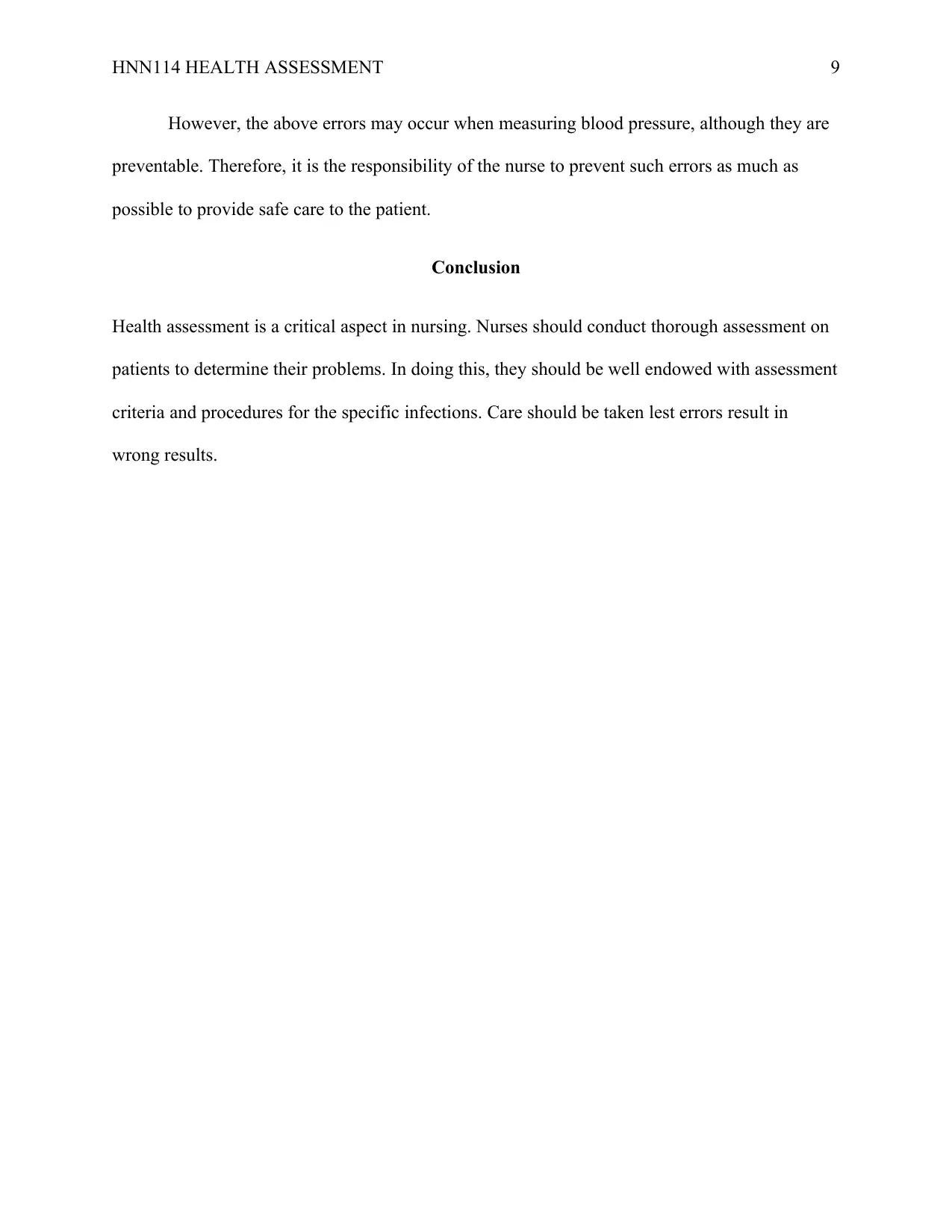
HNN114 HEALTH ASSESSMENT 9
However, the above errors may occur when measuring blood pressure, although they are
preventable. Therefore, it is the responsibility of the nurse to prevent such errors as much as
possible to provide safe care to the patient.
Conclusion
Health assessment is a critical aspect in nursing. Nurses should conduct thorough assessment on
patients to determine their problems. In doing this, they should be well endowed with assessment
criteria and procedures for the specific infections. Care should be taken lest errors result in
wrong results.
However, the above errors may occur when measuring blood pressure, although they are
preventable. Therefore, it is the responsibility of the nurse to prevent such errors as much as
possible to provide safe care to the patient.
Conclusion
Health assessment is a critical aspect in nursing. Nurses should conduct thorough assessment on
patients to determine their problems. In doing this, they should be well endowed with assessment
criteria and procedures for the specific infections. Care should be taken lest errors result in
wrong results.

HNN114 HEALTH ASSESSMENT 10
References
Jarvis, C., Forbes, H., & Watt, E. (2016). Jarvis’s physical examination and health assessment
(2nd ed.). Chatswood: Elsevier
Martini, F. H., Nath, J. L., & Bartholomew, E. F. (2015). Fundamentals of Anatomy and
Physiology. 2001. Pentice Hall: New Jersey, 538-557.
Leung, A. A., Nerenberg, K., Daskalopoulou, S. S., McBrien, K., Zarnke, K. B., Dasgupta, K., ...
& Bolli, P. (2016). Hypertension Canada's 2016 Canadian hypertension education
program guidelines for blood pressure measurement, diagnosis, assessment of risk,
prevention, and treatment of hypertension. Canadian Journal of Cardiology, 32(5), 569-
588.
References
Jarvis, C., Forbes, H., & Watt, E. (2016). Jarvis’s physical examination and health assessment
(2nd ed.). Chatswood: Elsevier
Martini, F. H., Nath, J. L., & Bartholomew, E. F. (2015). Fundamentals of Anatomy and
Physiology. 2001. Pentice Hall: New Jersey, 538-557.
Leung, A. A., Nerenberg, K., Daskalopoulou, S. S., McBrien, K., Zarnke, K. B., Dasgupta, K., ...
& Bolli, P. (2016). Hypertension Canada's 2016 Canadian hypertension education
program guidelines for blood pressure measurement, diagnosis, assessment of risk,
prevention, and treatment of hypertension. Canadian Journal of Cardiology, 32(5), 569-
588.
1 out of 10
Your All-in-One AI-Powered Toolkit for Academic Success.
+13062052269
info@desklib.com
Available 24*7 on WhatsApp / Email
![[object Object]](/_next/static/media/star-bottom.7253800d.svg)
Unlock your academic potential
© 2024 | Zucol Services PVT LTD | All rights reserved.